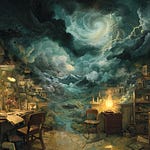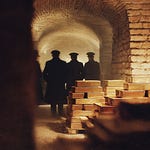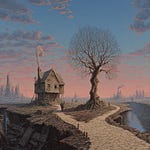NB My next Best In Class, in which I identify the go-to stocks in the natural resources sector, is out tomorrow. Keep an eye out for that. (Only for paid subscribers).
Today, though, gold …
I am going to the Edinburgh Fringe this August to do one of my lectures with funny bits. This one is about gold - its history, its fascination, its future. It really is the most amazing metal, not least because it is, as Spandau Ballet famously sung, indestructible. Life may be temporary, but gold is permanent.
No other substance is as durable, not diamonds, not tungsten carbide, not boron nitride.
You can shape this enormously ductile metal into pretty much anything. An ounce of gold can be stretched into a wire fifty miles long. You can beat it into a leaf just one atom thick. Yet there is one thing you cannot do and that is destroy it.
You can change its form by dissolving it in certain chemical solutions or alloying it with other metals. You can even vaporise it. But the gold will always be there. It is theoretically possible to destroy gold through extreme methods such as nuclear reactions, but in practical terms, gold is indestructible. That makes it unique among natural substances: the closest thing we have on Earth to immortality. Perhaps that is why practically every ancient culture we know of associated gold with the gods, why the Egyptians believed it had magical powers that gave you safe passage into the afterlife.
In a museum in Cairo you will find a golden tooth bridge made for a well-to-do Egyptian 4,500 years ago. It is good enough to go in someone’s mouth today, (though I would give it a good scrub first). In 2021 a metal detectorist by the name of Ole Ginnerup Schytz unearthed a Viking gold hoard in a field near Jelling in Denmark. The gold was just as it was when it was buried 1500 years earlier, if a little dirtier. Gold does not corrode, it does not tarnish, it does not break down over time.
All the gold that has ever been mined, save the tiny amounts dissolved in aqua regia (nitrohydrochloric acid), still exists in the world in one form or another. Some may have been lost, but none of it has been destroyed. What’s more, it will always exist. Even tiny specks of gold dust are permanent.
Park that thought for a moment, as we consider how gold came into existence. No one really knows the answer to that.
Divine creation is one widely held theory. Another is that gold’s origins lie in supernovae and the collision of neutron stars.
Scientists think they actually witnessed gold being created in August 2017. Some 130 million light-years away, two neutron stars, each as small as a city but heavier than the sun, collided. The collision caused a colossal convulsion known as a kilonova. An enormous amount of energy was then released in the form of gravitational waves and electromagnetic radiation, including visible light, which was observed by telescopes around the world as it rippled through space and time to Earth.
Astronomers were able to measure the amount of heavy elements produced by the collision, because of the multiple wavelengths and bright optical and infrared glow. Something like 16,000 earth masses of material was hurtled into space, says Harvard astronomer Edo Berger, creating “10 times the Earth's mass in gold and platinum alone". (Gold, by the way, makes up about one millionth of the Earth's mass, and most of that is still in the planet's core.)
"It makes it quite clear that a significant fraction, maybe half, maybe more, of the heavy elements in the Universe are actually produced by this kind of collision," said physicist Patrick Sutton of the Laser Interferometer Gravitational-Wave Observatory in the US. High temperature and high pressure in the cores of neutron stars, argue scientists, cause atomic nuclei to capture free neutrons in a process known as "neutron capture." The resulting nuclear reactions then lead to the formation of gold. When these neutron stars eventually die, they explode as supernovae, and disperse the gold and other elements that were created into space.
Perhaps the Incas and Aztecs were not so wrong to see gold as the tears of the sun.
Our solar system (the sun and everything that orbits it) was formed from the cloud of gas and dust – a so-called solar nebula - that resulted from one such stellar collision. Small, solid objects - planetesimals - then formed by accretion: the process of gravitational attraction by which small particles in space stick together. These planetesimals grew and grew, through continued accretion and collision, to eventually form the planets.
In short, gold was present in the dust that formed the solar system four and a half billion years ago. Being permanent, it is exactly the same today as it was then. Isn’t that an amazing thought? That little bit of gold you may be wearing on your person is older than the Earth itself. In fact, it is older than the solar system, as old as stardust. To touch gold is as close as you might ever come to touching eternity.
Yet this eternal substance is as good as useless.
Unlike other metals, which we use to build things, cut things or conduct things, gold’s industrial use is so limited as to be non-existent. It is a good conductor of electricity, but copper and silver are better and cheaper. It has some use in dentistry and in medical applications, such as radiation therapy and the treatment of arthritis, but such uses are minimal in the greater context.
Gold’s purpose is as a store or display of wealth. It has no other significant use. It is dense, tangible value: pure money.
Over the years we have used all sorts of different things as money: shells, whales’ teeth, pieces of specially printed paper, computer bits, promises. Today, packets of mackerel serve as currency in US penitentiaries - “macks,” they are known as. But one has outlasted them all, and that is gold.
My show on gold at the Edinburgh Fringe this August will take place at Panmure House, the room in which Adam Smith wrote Wealth of Nations. You can get tickets here.
Interested in buying gold to protect yourself in these uncertain times? My recommended bullion dealer is The Pure Gold Company, whether you are taking delivery or storing online. Premiums are low, quality of service is high. They deliver to the UK, US, Canada and Europe, or you can store your gold with them. More here.
This article first appeared at Moneyweek.














